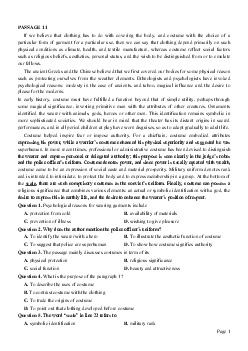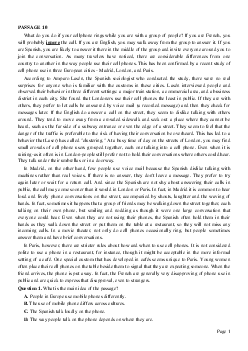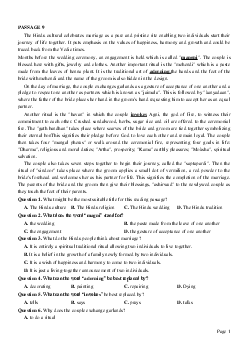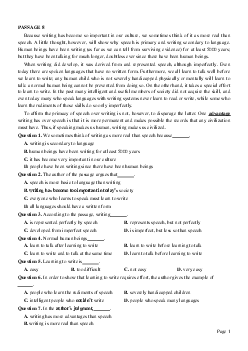


Preview text:
PASSAGE 1
As Christmas evolved in the United States, new customs were adopted and many old ones were reworked.
The legend of Santa Claus, for example, had origins in Europe and was brought by Dutch settlers to New
York in the early 18th century. Traditionally, Santa Claus – from the Dutch Sinter Klaas – was depicted
as a tall, dignified, religious figure riding a white horse through the air. Known as Saint Nicholas in
Germany, he was usually accompanied by Black Peter, an elf who punished disobedient children. In
North America he eventually developed into a fat, jolly old gentleman who had neither the religious
attributes of Saint Nicholas nor the strict disciplinarian character of Black Peter.
Santa’s transformation began in 1823, when a New York newspaper published the poem A Visit from
Saint Nicholas, which Clement Clark Moore had written to amuse his daughter. The poem introduced
many Americans to the story of a kindly saint who flew over housetops in a reindeer-drawn sleigh.
Portraits and drawings of Santa Claus by American illustrator Thomas Nast further strengthened the
legend during the second half of the 19th century. Living at the North Pole and assisted by elves, the
modern Santa produced and delivered toys to all good children. By the late 19th century he had become
such a prominent figure of American folklore that in 1897, when Virginia O’Hanlon wrote to the New
York Sun newspaper asking if Santa was real, she received a direct answer: “Yes, Virginia, there is a Santa Claus”.
Question 1. Who brought the legend of Santa Claus to the USA according to the passage? A. Sinter Klaas B. Saint Nicholas C. A German D. Dutch settlers
Question 2. Santa Claus was traditionally described as a
A. tall man who could walk through the air B. fat, jolly, old man C. religious figure
D. fat man riding a white horse
Question 3. Santa Claus in North America was depicted as
A. a man with the strict disciplinarian character of Black Peter
B. a jolly man on horseback
C. a good old man with less religious character
D. one with religious attributes of Saint Nicholas
Question 4. Who was Black Peter?
A. an elf accompanying Saint Nicholas
B. an elf who rode a white horse
C. one of the disobedient children
D. a popular traditional figure
Question 5. What word is closest in meaning to attributes? A. outer appearance B. natural qualities C. effects D. symbols of a person
Question 6. Where did the legend of Santa Claus come from? A. the North Pole B. Europe C. North America
D. the City of New York
Question 7. 1823 was mentioned as a year when
A. Clement Clark Moore wrote his first poem
B. Clement Clark Moore’s poem made him popular
C. Saint Nicholas visited New York
D. the image of Santa Claus was transformed
Question 8. According to Clement Clark Moore’s poem
A. Santa Claus had nothing different in appearance from the traditional one
B. Santa Claus had wings and could fly Page 1
C. Santa Claus liked poetry
D. Santa Claus was a kindly saint who flew over housetops in a sleigh
Question 9. The answer Yes, Virginia, there is a Santa Claus is an illustration for the fact that
A. the New York Sun was popular with children
B. Santa Claus was a prominent figure at that time
C. newspapers are unreliable
D. Virginia O’Hanlon was a reader of the New York Sun
Question 10. Which of the following statements is TRUE?
A. Santa Claus was an imaginary old man created by artists based on traditional figures
B. Living in the North Pole, Santa Claus visited children at Christmas
C. Santa Claus was a real figure living in northern America
D. Santa Claus was a story based on Saint Nicholas and Black Peter ĐÁP ÁN 1-D 2-C 3-B 4-A 5-B 6-B 7-D 8-D 9-B 10-A
LỜI GIẢI CHI TIẾT Question 1: Dutch settlers
Thông tin ở đoạn sau:” The legend of Santa Claus, for example, had origins in Europe and was brought
by Dutch settlers to New York in the early 18th century. Traditionally, Santa Claus – from the Dutch
Sinter Klaas – was depicted as a tall, dignified, religious figure riding a white horse through the air.”
(Huyền thoại về Ông già Tuyết, ví dụ như, có nguồn gốc từ Châu Âu và được đưa vào New York bởi
những cư dân Hà Lan vào đầu thế kỉ 18. Theo truyền thống, ông già tuyết – đến từ vùng Sinter Klaas Hà
Lan – được mô tả với vẻ cao, đĩnh đạc, có tính tôn giáo cưỡi một con ngựa trắng qua không trung.) Question 2: Religious figures
Thông tin ở đoạn sau: “Traditionally, Santa Claus – from the Dutch Sinter Klaas – was depicted as a tall,
dignified, religious figure riding a white horse through the air.”
(Theo truyền thống, ông già tuyết – đến từ vùng Sinter Klaas Hà Lan – được mô tả với vẻ cao, đĩnh đạc,
có tính tôn giáo cưỡi một con ngựa trắng qua không trung.) Question 3: A jolly man on horseback
Thông tin ở đoạn sau: “In North America he eventually developed into a fat, jolly old gentleman who had
neither the religious attributes of Saint Nicholas nor the strict disciplinarian character of Black Peter.” (Ở
Bắc Mỹ ông thường được hư cấu là một người đàn ông lịch thiệp béo và vui vẻ, mà không được quy cho
là thánh Nicholas hay nhân vật nghiêm nghị, có kỉ luật nào của Black Peter.) Question 4: Page 2
An elf accompanying Saint Nicholas
Thông tin ở đoạn sau: “Known as Saint Nicholas in Germany, he was usually accompanied by Black
Peter, an elf who punished disobedient children.” (Được biết đến như là thánh Nicholas ở nước Đức, ông
thường được liên hệ với Black Peter, một tiểu yêu đi phạt những đứa trẻ không nghe lời.) Question 5:
Natural qualities = tính chất tự nhiên, vốn có Question 6: Europe
Thong tin ở đoạn sau: “The legend of Santa Claus, for example, had origins in Europe and was brought
by Dutch settlers to New York in the early 18th century” (Huyền thoại về Ông già Tuyết, ví dụ như, có
nguồn gốc từ Châu Âu và được đưa vào New York bởi những cư dân Hà Lan vào đầu thế kỉ 18.) Question 7:
The imagine of Santa Claus was transformed
Thông tin ở đoạn sau: “Santa’s transformation began in 1823, when a New York newspaper published the
poem A Visit from Saint Nicholas, which Clement Clark Moore had written to amuse his daughter. The
poem introduced many Americans to the story of a kindly saint who flew over housetops in a reindeer-
drawn sleigh. Portraits and drawings of Santa Claus by American illustrator Thomas Nast further
strengthened the legend during the second half of the 19th century. Living at the North Pole and assisted
by elves, the modern Santa produced and delivered toys to all good children.” Question 8:
Santa Claus was a kindly saint who flew over housetops in a sleigh
Thông tin ở đoạn sau: “Santa’s transformation began in 1823, when a New York newspaper published the
poem A Visit from Saint Nicholas, which Clement Clark Moore had written to amuse his daughter. The
poem introduced many Americans to the story of a kindly saint who flew over housetops in a reindeer- drawn sleigh.”
(Sự biến đổi ông già tuyết bắt đầu vào năm 1823, khi một tờ báo của New York xuất bản bài thơ Một
chuyến thăm từ Thánh Nicholas, mà Clement Clark Moore đã viết để làm vui lòng con gái mình. Bài thơi
giới thiệu cho nhiều người Mỹ một câu chuyện về một vị thánh tốt bụng, bay qua các nóc nhà trên một cỗ xe tuần lộc.) Question 9:
Santa Claus was a prominent figure at that time
Thông tin ở đoạn sau: “By the late 19th century he had become such a prominent figure of American
folklore that in 1897, when Virginia O’Hanlon wrote to the New York Sun newspaper asking if Santa was
real, she received a direct answer: “Yes, Virginia, there is a Santa Claus”.” (Đến cuối thế kỉ 19, ông già
tuyết đã trở thành một hình tượng nổi bật của dân gian Mỹ mà vào năm 1897, khi Virginia O’Halon viết
trên tờ New York Sun hỏi liệu ông già tuyết có thật không, bà đã nhận được ngay một câu trả lời: “Có
chứ, Virginia, có ông già tuyết đấy.”) Question 10:
Santa Claus was an imaginary old man created by artists based on traditional figures = Ông già tuyết là
một người đàn ông già đầy hình tượng được những người nghệ sĩ sáng tạo dựa trên các hình tượng dân gian Page 3




